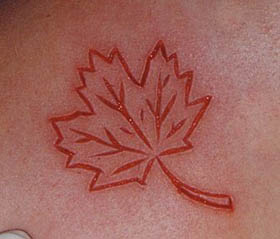Cutting
Cutting is one of the two most common types of scarification (see also: Skin Removal). Cutting consists of drawing a predefined design on the skin via usage of a surgical blade or scalpel. Cutting for negative emotional reasons is considered self-harm.
Contents |
Tools
Surgical scalpels are better suited to the task than X-acto or similar blades; hobby blades are no sharper than surgical blades (in general, they are far duller). They are wider though, with multiple microscopic serrations giving the illusion of feeling sharper, but actually causing them to slightly rip the tissue they're cutting through rather than making a clean slice. In addition, many hobby blades contain a thin coating of machine oil which can irritate the wound (and not in a good way).
That said, even though hobby blades are not acceptable for scarification, some artists prefer their handles to those of surgical blades. Surgical blades may be mounted in the handles of hobby blades, but this is entirely up to the personal style of the artist.
A small star outline, for example, might use one scalpel per point because scalpels are meant for only one cut. Fortunately, disposable scalpels with handles are relatively inexpensive; disposable scalpels without handles are priced so inexpensively that one could just change blade after only one cut. Cutting with a dulled scalpel increases the pain of the procedure.
Procedure
It is generally no more than 3 millimeters in depth, dependent on the area of the body being cut. It also can be widened without needing to deepen the cut more. The idea is to make an even and consistent cut without actually removing a piece of skin. Aftercare is generally dependent on the desired result, and the practitioner should be able to recommend an appropriate aftercare regimen to help achieve that result.
The pain associated with a cutting project has been commonly compared with that of getting a tattoo, but note that pain sensation and tolerance vary widely from person to person. Trusting the artist, a comfortable location, and not (initially) looking at the cutting in progress does help in minimizing noticing the pain of the cutting. Even so, the portion of the cutting involving removing small strips of skin will hurt about as much as play piercing would.
Packing
If deep cuts are made on an angle, the resulting wound can be packed with "relatively inert" clay and other substances. While this type of scarification is largely unheard of in the West, it was quite common in Africa until recently.
During healing, massive scars envelop or force out the clay—this is one of the harshest methods of scarring, but is by far the most effective if huge keloids are sought. That said, the results are not generally even, so be prepared for something that nearly everyone will assume was a horrible, horrible accident. Recutting and repacking can be used to fine-tune the results.
Please note that NO reputable practitioners will offer advanced techniques such as this to the general public (nor should they).
